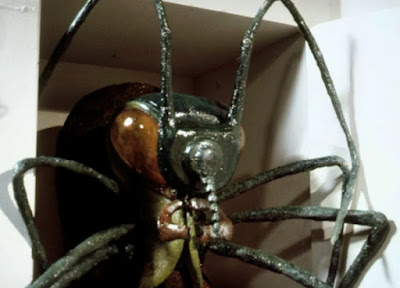DOCTOR WHO - THE MASQUE OF MANDRAGORA (1976)
DOCTOR WHO - THE HAND OF FEAR (1976)
An adult Wirrn from THE ARK IN SPACE. Originating from Andromeda, these aliens are "almost too horrible to think about."
ALTHOUGH the script for what would become the DOCTOR WHO adventure THE ARK IN SPACE was commissioned during Barry Letts' show running tenure, it fell to incoming producer Philip Hinchcliffe and script editor Robert Holmes to bring this classic tale of bodily possession to life. Screened as the second story of the programme's Season Twelve, and scripted by Holmes from an original draft by John Lucarotti, it tells of the insectoid Wirrn Queen laying eggs inside cryogenically-preserved humans on the future space "ark" Nerva; when the eggs begin to hatch and the monsters start to absorb homo sapien knowledge as well as their bodies, The Doctor (Tom Baker), Sarah Jane (Elisabeth Sladen) and Harry (Ian Marter) team up with revived humans to lure hatched Wirrn into a shuttle craft and blast them into space.
THE ARK IN SPACE's body horror is played out in Roger Murray-Leach's brightly lit, clinical sets, and its claustrophobia and trails of green slime couldn't have been further from the atmosphere of the previous serial, ROBOT. Noah (Kenton Moore)'s unnerving cell-by-cell mutation into an insectoid not only recalls the fate of Carroon in THE QUATERMASS EXPERIMENT, but provides a bridging point for body-destruction explored in major motion pictures such as ALIEN and THE THING (the shuttle craft finale also provides a nod to Ridley Scott's film). The Wirrn grubs and flesh of Noah's transforming hand were constructed primarily from then new bubble-wrap packaging and sprayed green, and to further illustrate the show's queasy hue, the opening titles to Part One were green-tinted as an experiment but consequently dropped.
THE MASQUE OF MANDRAGORA is one of the most literate of all DOCTOR WHO's; not only is Mandragora the latin for the plant Mandrake, which in folklore is said to have magical qualities, the serial has also been equated to Hamlet's discussions on the supernatural.
The Fourteenth Season of DOCTOR WHO opened with two stories that also explored the Hinchcliffe/Holmes brand of control. THE MASQUE OF MANDRAGORA is a sumptuous costume drama set during Renaissance Italy (which was actually filmed in Portmeirion). The TARDIS lands unwittingly carrying Mandragora energy, that possesses an underground cult - the outlawed Brotherhood of Demnos - intent on dragging the world back to the Dark Ages. Portmeirion's locations fit in perfectly for 15th century Italy, as the architect for the Welsh village - Sir Clough Williams-Ellis - was inspired by the Italian harbour town of Portofino. This mixture of history and black magic come to life in Louis Marks' intelligent scripts, using the Madragora Helix to symbolise superstition that would be negated by science ("the dawn of a new reason"), and Barry Newbery's design for the wood-panelled console room is a thing of beauty.
THE HAND OF FEAR is set on contemporary Earth, and sees Sarah Jane possessed by the fossilised hand of Kastrian Eldrad (Judith Paris/Stephen Thorne), a criminal who was destroyed in space as punishment for attempting to wipe out his own race. Sarah Jane hijacks a nuclear reactor where radiation recreates the creature; regenerated, Eldrad persuades The Doctor to take him back to Kastria, but the planet has been destroyed by King Rokon (Roy Skelton) in case Eldrad should ever return. At its conclusion, The Doctor receives a summons from the Time Lords, forcing him to leave Sarah on Earth; this action would result in the ground-breaking THE DEADLY ASSASSIN.
Judith Paris as the reconstituted Eldrad in THE HAND OF FEAR.
Disembodied hands have a long tradition in pop culture. Amicus in particular enjoyed the malevolent severed organ, and here the impressively realised digit is brought to life by Steve Drewett and CSO. But this is a serial for the women; in her female form Eldrad presents a ruthless beauty, and Sladen is threatening while under the influence, then feistily accepting in her farewell scene. In fact, THE HAND OF FEAR is the perfect story to showcase the most popular of the Time Lord's assistants. Sladen appeared in eighty episodes between 1973 and 1976, and through subsequent audio dramas, reboot appearances and spin-offs, new generations could also fall in love with her grounded yet infectious charm. Sladen's swift death from pancreatic cancer in April 2011 left the Whovian community in shock, and BBC Four fittingly showed THE HAND OF FEAR as a tribute to Sladen's timeless appeal.



